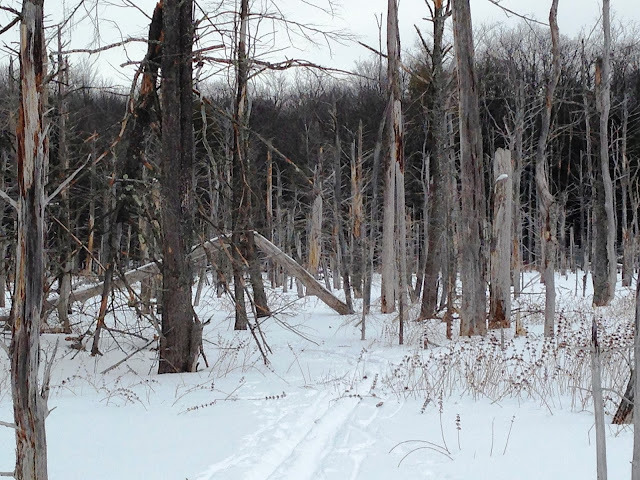 |
| Happy Valley Wildlife Management Area provides habitat for a number of species, including snowshoe hares. (photos by Janet Clerkin) |
For instance, we’re one of the few counties in the state that boast cottontail rabbits and varying hares, commonly called snowshoes. While both belong to the family Lagomorph and look the same, the resemblance stops there. Hares are almost twice as big as cottontails, don’t burrow, bear young dressed in full coats of fur, and hit the ground running almost as soon as they’re born. What’s more, cottontails stay brown year-round and cotton to fields; whereas snowshoes turn white in winter and thrive in woods.
Cottontails are the state’s most common rabbit. One of the main reasons is because they’re burrowing critters, and run for the safety of their holes at the first sign of danger. Their favored habitat is fields, particularly in farm country.
Snowshoes, on the other hand, are forest creatures. Their preferred range is early successional habitat, particularly stands of young pines offering low branches for cover.
Their preference for hiding under bushy trees rather than jump into a hole makes them extremely vulnerable to predation, especially by coyotes. So a small wood patch won’t do. They need large forests--like the ones found in northern Oswego County--to keep a safe distance from predators.
Snowshoes had their heyday in the middle of the last century, after massive numbers of hardscrabble farmers gave up trying to eke a living out of the poor soil in the county’s northeastern corner and abandoned their homesteads. Nature took over, spreading new growth over the barren fields.
Snowshoes from “Up North” came down, found the browse to their liking-- and settled in. The rich food supply and ample cover lead to an explosion in their numbers.
The forests are older now, their branches too high to offer snowshoes much food or cover. Still, there’s enough low browse around to support hares. Indeed, Oswego County is famed for being one of the varying hares’ southernmost ranges in the state.
There ain’t many of ‘em--compared to cottontails--so you’ll have to work to get them. Bear in mind, however, they’re twice as big as bushytails so you don’t need as many.
The best spot to hunt them around here is 8,645-acre Happy Valley Wildlife Management Area. Roughly three miles of NY 104 runs along the north end, about four miles east of I-81.
A few other good spots to try include the 538-acre Salmon River Reforestation Area (split in half by CR 2, about 10 miles east of Pulaski) and 8,020-acre Little John Wildlife Management Area (off CR 17, in the northeastern corner of the county).





